Beamer’s bald face pokes out from his stall door at Norberg Farm in Menomonee Falls, Wis., and watches as Todd Gillis approaches. The 19-year-old Bay looks like any other well-behaved Quarter Horse. His ears are forward, he’s curious and sociable.
When Gillis swings the door open, though, it’s evident Beamer isn’t an everyday, run-of-the-mill horse. Beamer’s left front leg is twice as large as the right. What’s even more striking, though, is it has two hoof walls — one originates from the natural coronary band, while the second begins about 2 inches above.
The Richfield, Wis., farrier clips on a lead rope and asks Beamer to follow. The horse puts his head down like he’s about to gain leverage to pull a heavy load and starts his journey to the shoeing area.
As he makes his way across the loose, dirt floor, Beamer is slow and deliberate. The swelling in his left front leg doesn’t allow him to flex his coffin joint, pastern joint, nor his fetlock joint. He’s almost swinging the swollen limb as if he has a wooden leg.
How We Got Here
As documented in the December 2004 issue of American Farriers Journal, the Quarter Horse had no known medical problems when Caryl Mayer bought him in early 2003. Mayer’s husband called him Beamer, joking that he’ll never be able own a BMW after his wife bought the horse.
Just a few months later, Beamer was vaccinated for strangles, which is a highly contagious, bacteria-borne respiratory disease. Shortly after, Beamer started experiencing swelling, particularly in his limbs. A veterinarian diagnosed purpura hemmorhogica, a rare complication of equine strangles that can include fever, muscle soreness and swelling of the body and limbs.
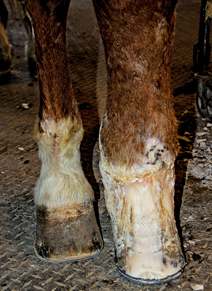
Beamer’s left front leg is twice the size of the other. The swelling doesn’t allow him to be able to flex his coffin joint, pastern joint, nor his fetlock joint.
Despite treatment, a “bubble” formed on the left front coronary band. As the swelling continued, the skin on his legs split and pulled away from the underlying tissue, as well as from the coronary band on the left front limb. The hoof capsule became distorted and had very little growth. It’s not unusual for a horse to be euthanized when it develops purpura to this degree because the bony column often rotates and laminitis ensues. Yet, X-rays showed that there were no internal problems.
Mayer wrapped the legs three times a day for several months while the purpura was brought under control.
“She went through all of this,” Gillis says. “At times, it was pretty trying whether she should make the next step or not.”
Why didn’t she euthanize Beamer?
“I asked the vet, ‘Why didn’t you tell me to put him down?’” she recalls. “‘Because Beamer didn’t tell me to,’ he
told me.”
While Beamer was on 6 months stall rest, a second hoof capsule began forming about 2 inches above the natural coronary band. With the help of vets, Gillis trimmed the second hoof wall every 3 to 4 weeks to prevent it from growing into the original hoof wall.
“It just grows in layers,” he says. “We just kind of chipped away at it. It bled sometimes. I just try to trim it back as I’m advised by the vets.”
Farrier Takeaways
While most horses founder after being diagnosed with purpura hemmorhogica, X-rays reveal that Beamer’s bony column remains fine.
X-rays are taken every 12 to 18 months to monitor the bony column.
It’s often easier on the horse to trim and shoe the affected foot on one day, then work on the other feet a few days later.
To keep the horse supported, Todd Gillis backs up the toe, and sets an aluminum shoe back as far as possible to help with breakover.
It’s not certain why the extra hoof wall began growing, but Beamer’s vets have a theory.
“They thought that maybe when he got purpura, his legs blew up so big that the coronary band detached from where it was and moved up the leg because of the swelling,” explains Gillis, who has been shoeing for about 34 years. “As the swelling went down, they think it possibly attached above it.”
A Dozen Years Later
It might not be known why the extra hoof wall is growing, but what is certain is Beamer grows a lot of hoof wall.
“I just trim that hoof as much as I can, and as well as I can,” he says. “Then, I trim off the top hoof wall. I would say it grows about 1 inch to 1 1/2 inches thick on the pastern between 5 and 6 weeks.”
Beamer’s vet takes X-rays every 12 to 18 months “just to see where we are down there,” Gillis says.
“He’s not badly aligned,” he says. “By looking at it, you’d think he’d be totally off. The finished product isn’t always pretty, but it sure seems we have him aligned to where he wants to breakover and use it.”
To make it easier on Beamer, Gillis only will be trimming and shoeing the left front foot on this day.
“A lot of times, I will let the other feet go for a week because it’s hard for him to stand on the left front,” Gillis says. “I just usually have to do him in stages. Sometimes I’ll be back at the end of the week to do a horse or two and I’ll just throw him on the schedule and do the other three feet. So that’s what we’ve been doing lately, and it seems to be working fine.”
PHOTO GALLERY:
Todd Gillis: Keeping Beamer Comfortable
After lifting the foot and placing it on a hoof stand, Gillis puts his GE nippers to work on the upper hoof wall. Long, vertical pieces of hoof wall break off each time Gillis closes the reins of the tool.
“It’s just like a shell,” he says, “that grows around the pastern.”
After removing hoof wall for about 4 minutes, Gillis puts Beamer’s foot down to give him a break.
“It’s hard to say exactly where that (original) hoof wants to start,” he says. “I’m going to dig a little more where the natural coronary band usually begins to see if I can find it. It just kind of blends right in and grows together.”
After about a minute and a half, Gillis settles to his knees on the floor and continues nipping the junction between the two hoof walls — this time without the hoof stand.
“His foot just isn’t healthy,” he says. “I don’t think it gets the right amount of blood flow because of what happened. The swelling is about average for what this leg stays like. He’s got ringbone that has kind of fused. He’s just got a mess going on in there. So, we just try to keep him to where he’s comfortable.”
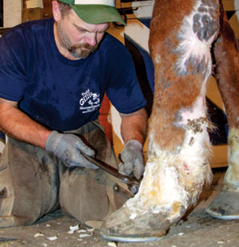
Todd Gillis gives Beamer a break by getting down on his knees and trimming the top hoof wall.
Comfort Is Easier Said Than Done
Over the years, comfort for Beamer is a moving target.
“We just want a shoe set back as far as it can be to provide support and give him some breakover,” Gillis explains as he places the foot on the hoof stand and rasps the hoof wall. “I have a Victory Elite aluminum shoe on with a 3-degree Natural Balance frog support pad.”
He pushes his fingers into the area above the natural coronary band, then retrieves his nippers and removes a little more of the shelly hoof wall. At times, it’s still trial and error.
“We keep trying to change it a little bit,” Gillis says. “I’d like to see that shoe back another 4 inches when I get done, but there’s just nothing to nail to. I moved it back about 1/4 of an inch one time and he seemed to get sore if I gave him even more support back there. We’ve had bar shoes on him. We’ve had other shoes and this just seems to work the best for him. You’ll see when I open this up, it’s just not a healthy foot.”
After pulling the shoe and cleaning out the foot, he uses a thin-blade Frost hoof knife to remove exfoliating frog. He switches to a wide-blade knife to trim the sole. In comparison to a typical sole, Beamer is “a lot softer. He’s just very soft.”
“With everything happening inside his foot, he just squashes his heels and runs his toe out,” Gillis says. “So I back up the toe every time and try to get him supported underneath his limb, which is real hard to do. He’s just way, way out forward.”
He sets Beamer’s foot down, which begins a slow dance in search of comfort.
“He doesn’t like it without a shoe or a pad on,” Gillis says while removing the nails that bind the shoe and pad together. “I just give him little breaks in between because it’s kind of tough for him. I think he supports everything on his right front.”
The Quarter Horse is on a 6-week schedule, for the most part. He’s checked regularly, though, for changes.
“At times we throw him on a 5-week schedule, depending on how he’s growing,” Gillis says while rasping the foot level. “Since I’m here every week, I just look at him every couple of weeks just to see where I think I need to be with him.”
Beamer only goes outside about 3 or 4 days a week. Since he’s not as active as other horses, Gillis can get three or four resets out of an aluminum shoe.
“Shoes last quite a while with him,” he says. “Usually when I get done with him, his leg is a little sore for a day. The last time, he was real good for quite a while.”
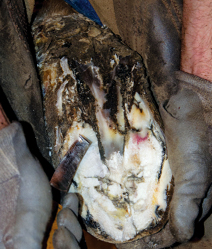
Beamer’s heels are squashed and he runs his toe out. Gillis backs up the toe each time and sets the shoe back to provide the support he needs.
Although weather determines when he’s turned out, the horse generally makes the decision.
“If you can believe it, he tells you when he can go outside,” Gillis says. “A lot of days, he just wants to stay in. Sometimes it’s just out in the paddock if the pasture is in real deep mud. Otherwise, he goes out in the pasture. He does move around, trot, kick, buck and roll.”
It’s difficult, though, to determine why Beamer is experiencing pain after shoeing.
“Is it because of the way I set him?” Gillis asks rhetorically. “Is it because I’m moving his joints more? Or, is it because I’m goofing with the second hoof wall? I do believe by trimming all that off, it changes some stuff up there. Then, he seems to get better again. Sometimes it’s only a day and he’s walking off pretty darn good.”
With a nail clenched between his teeth, and the shoe and pad in hand, Gillis retreats to his shoeing trailer to retrieve two plastic jars of Equilox hoof support impression material. He grabs a handful of the soft pink material and mixes it with some harder material.
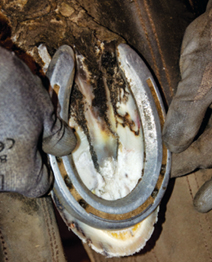
Gillis would prefer to set the shoe back even more to offer better support, but there’s just not enough foot to nail to.
“I always roll it in copper sulfate to kind of keep the moisture down, too,” Gillis says as he dips the material into the container.
Returning to the horse, Gillis applies the impression material to the caudal aspect of the foot and frog area. Placing the shoe and pad package on the foot with his left hand, Gillis reaches into his shoeing box for the driving hammer and retrieves the nail from his mouth. Gillis taps the nail into the second toe nail hole on the lateral side to set it, then quickly strikes the nail twice. The concussion is causing Beamer some discomfort. Gillis staggers his blows to give Beamer a break. By the time the last blow is struck, Beamer doesn’t move.
Gillis repeats the process with a nail in the second toe nail hole on the medial side. After tapping three times to set the nail, Beamer shifts. “OK, baby,” Gillis says softly. He strikes the nail quickly three times. Gillis pauses for 2 seconds before taking two more blows. He pauses a second time, then strikes one more time before setting the foot down.
Beamer picks up the foot and sets it down several times, each with a pause after loading. It’s something he’s always done a little bit with both front feet, Gillis says. After taking a couple of passes with the nippers to remove excess toe, he rasps it and sets the foot down. Beamer repeats his earlier dance. Gillis stands with hands on hips in front of the horse and studies him as he takes a step back and a step forward. After about 18 seconds, Beamer finds his comfort zone and stops shifting.
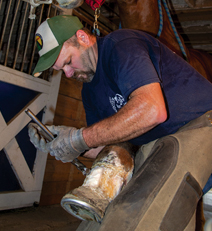
Beamer’s extra hoof wall, which is fairly shelly, grows about 1 inch to 11/2 inches every 6 weeks.
“So where does that hoof start and finish?” Gillis says. “We’re not sure, are we? But, that sets the shoe back underneath it and gives him the support he needs. This is where he seems to be the happiest.
“Ready to go back Beam?”
The Walk Back
Leading Beamer back to his stall, it’s apparent he’s more comfortable. His stride is quicker and doesn’t seem to be laboring as much.
“When he came out, he was rocking way back on that foot,” Gillis says. “Just by shifting that shoe back, he lands straight. He wasn’t nearly as sore on the walk back. The finished product isn’t always pretty, but it sure seems we have him aligned to where he wants to breakover and use it.”
Under the circumstances, Mayer couldn’t be more pleased with Beamer and has no regrets.
“I couldn’t have done it without Todd,” she says. “We give him five stars, but don’t tell him.”








Post a comment
Report Abusive Comment